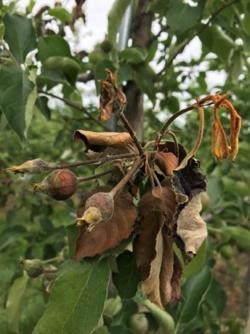This year’s rainy, warm spring could be problematic for orchards due to fire blight, says a fruit crop specialist with Iowa State University Extension and Outreach.
Conditions for most of Iowa were nearly perfect for the disease to spread, resulting in potential surprise flare ups, said Suzanne Slack, in a recent article for the Acreage Living Newsletter.

In her article, Slack highlights common symptoms and actions to take against fire blight.
Her article identifies common symptoms to watch for and action steps if detected. The symptoms include blossom blight, ooze droplets and shepherd’s crook.
She recommends orchard owners scout early and if detected, swiftly remove blighted fruit and shoots.
Slack says there are several commercial pesticide products labeled for shoot blight, which work by causing a defense response in the tree to prevent further spread.
“Our goal is to support Iowa apple growers in protecting their orchards from fire blight,” said Slack. “We hope this information encourages growers to take proactive steps and adopt sustainable practices to maintain healthy orchards.”
Other articles in the most recent Acreage Living Newsletter include “Good Biosecurity Didn’t Start with HPAI,” Iowa Fence Law FAQ, Pasture Management Options for Optimizing Grazing and Fertilization” and “Newly Updated Guides for Selling Timber.”
Acreage Living is published every other month by the Small Farm Sustainability team with the Farm, Food and Enterprise Development program of ISU Extension and Outreach.
Shareable photo: Picture of a fire blight infected apple flower one month after blooming. Note the start of shoot blight due to bacterial spread.
Author:
Suzanne Slack
Extension Fruit Crops Specialist
515-294-2751
slacksuz@iastate.edu



